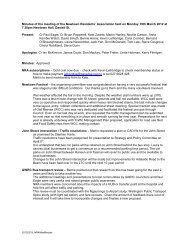Draft Town Belt Management Plan - Wellington City Council
Draft Town Belt Management Plan - Wellington City Council
Draft Town Belt Management Plan - Wellington City Council
You also want an ePaper? Increase the reach of your titles
YUMPU automatically turns print PDFs into web optimized ePapers that Google loves.
Figure 13: Te Ahumairangi Hill after storm damage in 2004<br />
Left: in 2005. Right: native revegetation 5 years later (in 2010)<br />
Compared to the largely failed plantings of the 1950s and 1960s, the revegetation planting of the<br />
last two or three decades has been more successful. Knowledge of revegetation techniques and<br />
native forest succession has developed nationally and the need for follow-up maintenance is now<br />
routinely recognised in budget planning. <strong>Plan</strong>ting has also increasingly focused on the use of ecosourced<br />
native plants that occur naturally in <strong>Wellington</strong>.<br />
Among the wide range of native species that were previously planted, karo, which is not natural to<br />
<strong>Wellington</strong> has become a pest plant particularly along the city’s coastal escarpments. Much of the<br />
<strong>Town</strong> <strong>Belt</strong> vegetation management is now focused on weed and pest control, enrichment planting<br />
to diversify the range of forest species and planting to attract the now proliferating native bird<br />
population.<br />
The value of green space<br />
Among the New Zealand Company’s motivations for creating town belts around its colonial<br />
settlements was the idea of creating green open space that would be the ‘lungs of the city’, as<br />
promoted by the Garden <strong>City</strong> Movement of the 19th century. The <strong>Town</strong> <strong>Belt</strong>’s 170-year history to<br />
date has seen the progressive realisation of that concept, following the initial setback when the land<br />
was cleared. The <strong>Town</strong> <strong>Belt</strong> plan 1840 along with the 1837 Adelaide plan are recognised as historic<br />
examples of the town <strong>Belt</strong>/green <strong>Belt</strong> concept in town planning.<br />
Walter Cook commented in his history of the <strong>Town</strong> <strong>Belt</strong>, that attempts to take <strong>Town</strong> <strong>Belt</strong> land for<br />
other purposes have often been based upon a perception of it being a useless and unsightly<br />
wasteland. He suggested that counteracting arguments have sought to show that the land is, on the<br />
contrary, being well utilised or improved. The early plantation plantings were justified in this<br />
way 115 . Now, in the 21 st century, open space advocates point to research which supports the concept<br />
that green open space does indeed act as the lungs of a city in terms of environmental servicing, as<br />
well as benefiting people’s wellbeing 116 .<br />
4. Other purposes and pressures on the <strong>Town</strong> <strong>Belt</strong><br />
Over its 170-year history, <strong>Town</strong> <strong>Belt</strong> land has been used and developed for purposes other than<br />
public recreation and scenic amenity. Some of those uses have been controversial; some have<br />
resulted in land being alienated; others are no longer considered suitable.<br />
115 Cook, “Background Report,” 16.<br />
116 <strong>Wellington</strong> Regional <strong>Council</strong>, <strong>Wellington</strong> Region Open Space Strategy and Action <strong>Plan</strong>, (<strong>Wellington</strong>, 2009).<br />
<strong>Draft</strong> <strong>Town</strong> <strong>Belt</strong> <strong>Management</strong> <strong>Plan</strong> October 2012<br />
219





